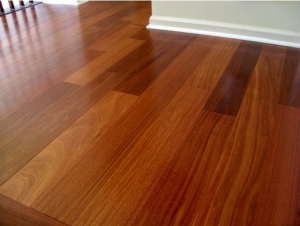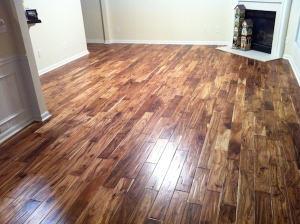Caring For Wood Floors
 Wood floors, properly finished, are the easiest of all floor surfaces to keep clean and new looking unlike carpeted or resilient floors that show wear regardless of care. Wood floors can be kept looking like new, year after year, with minimum care.
Wood floors, properly finished, are the easiest of all floor surfaces to keep clean and new looking unlike carpeted or resilient floors that show wear regardless of care. Wood floors can be kept looking like new, year after year, with minimum care.
Since the overwhelming majority of wood floors are composed of solid hardwood, this care guide applies specifically to this type of flooring.
Wood and water don’t mix. No matter what finish your wood floor has, NOFMA recommends, never pouring water on the floor. While a damp mop may be used on polyurethane and other surface finishes in good condition, excessive amounts of water seep between the boards and into small scratches causing deterioration of finishes. A damp mop should only be damp to the touch. It should be thoroughly wrung and not dripping.
Read the label. The recommendations made here are not intended to endorse specific products or brands but to serve as general guidelines in the selection and use of floor maintenance materials. Always follow label directions for finishes maintenance products, and corresponding products except for directions which call for using water on wood. Always use only products specifically designed for wood floors and the finish applied to your wood floor.
An Ounce of Prevention
 Advanced finish technology and innovative products make wood one of the most easy-care flooring materials today. A few preventive measures can preserve a beautiful finish and keep maintenance to a minimum.
Advanced finish technology and innovative products make wood one of the most easy-care flooring materials today. A few preventive measures can preserve a beautiful finish and keep maintenance to a minimum.
- Never use sheet vinyl or tile floor care products on wood floors or self polishing acrylic waxes because wood will become slippery and appear dull quickly. The only remedy in this situation is to sand and refinish the floor.
- Place mats and throw rugs at doorway interiors and exteriors to help prevent the tracking of grit, dirt and sand.
- Never wet-mop a wood floor. Standing water can dull the finish, damage the wood and leave a discoloring residue.
- Wipe up food and other spills immediately with a slightly dampened towel.
- Do not over-wax a wood floor. If the floor dulls, try buffing instead. Avoid wax buildup under furniture and other light traffic areas by applying wax in these spots every other waxing session.
- Put soft plastic or fabric-faced glides under the legs of furniture to prevent scuffing and scratching.
- When moving heavy furniture, completely pick up the furniture and carry rather than slide to best protect the wood flooring.
- For wood flooring in the kitchen, place an area rug in front of the kitchen sink.
- Use a humidifier in the home throughout the winter months to keep all wood movement and shrinkage to a minimum.
- In kitchens, use area rugs in high spill locations, work stations, stoves, sinks, and refrigerators. Cotton is generally the best fabric since it is easily washed. Mats with a smooth backing, i.e. rubber or vinyl, may trap water beneath.
- The fashionable high heels (and even styles with wedged heels) contain a steel spike - the equivalent of a blunt 10-penny nail — to strengthen the heel. If the leather or plastic cap is allowed t o wear down, or all the way off as frequently happens, the nails holding it and the center spike can become exposed. It has been projected that a two-ton car exerts only 28-30 pounds per square inch of pressure on its supporting surface, a full grown elephant 50-100 PSI, but a 125- pound woman as much as 2,000 PSI when taking a normal step. That’s because the lady’s heel measures only about 1/20th of a square inch in size. Her weight is concentrated in a tiny area and therefore its effect is multiplied many times.
Hardwood flooring manufacturers do not accept damage to floors caused by such heels as incurring a warranty obligation, nor do flooring installers. Such damage is not the result of manufacturing defects or installation method. Hardwood is a product of nature and therefore susceptible to abuse or mistreatment, and no type of finishing material will, as some people seem to believe, toughen the surface of the wood. In fact, finishes are softer than the wood and thus magnify the damage.
